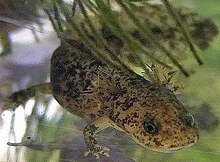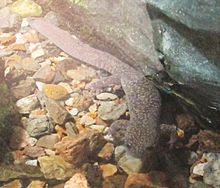Hida salamander: Difference between revisions
Content deleted Content added
m r2.7.3) (Robot: Adding sv:Hynobius kimurae |
Tom.Reding (talk | contribs) m WP:TREE cleanup++ and/or WP:GenFixes |
||
| (32 intermediate revisions by 23 users not shown) | |||
| Line 1: | Line 1: | ||
{{Short description|Species of amphibian}} |
|||
<!-- This article was auto-generated by [[User:Polbot]]. --> |
|||
{{Speciesbox |
|||
{{Taxobox |
|||
|name=Hida |
| name = Hida salamander |
||
|image=Hynobius kimurae (cropped) edit.jpg |
| image = Hynobius kimurae (cropped) edit.jpg |
||
| image2 = Hynobius kimurae (adult)2.jpg |
|||
| ⚫ | |||
| status = LC |
|||
|regnum=[[Animal]]ia |
|||
| ⚫ | |||
|phylum=[[Chordate|Chordata]] |
|||
| status_ref = <ref name="iucn status 16 November 2021">{{cite iucn |author=IUCN SSC Amphibian Specialist Group |date=2021 |title=''Hynobius kimurae'' |volume=2021 |page=e.T188970983A177183757 |doi=10.2305/IUCN.UK.2021-1.RLTS.T188970983A177183757.en |access-date=16 November 2021}}</ref> |
|||
|classis=[[Amphibian|Amphibia]] |
|||
| ⚫ | |||
|ordo=[[Caudata]] |
|||
| ⚫ | |||
|familia=[[Asiatic salamander|Hynobiidae]] |
|||
| ⚫ | |||
| ⚫ | |||
| synonyms = {{Species list |
|||
| ⚫ | |||
| Hynobius luteopunctatus | Hatta, 1914 — ''[[nomen nudum]]'' |
|||
| ⚫ | |||
| Pseudosalamandra hida | Tago, 1929 — ''nomen nudum'' }} |
|||
|synonyms=}} |
|||
| synonyms_ref = <ref name=Frost/> |
|||
The '''Hida Salamander''' (''Hynobius kimurae'') is a species of [[salamander]] in the [[Asiatic salamander|Hynobiidae]] family, that is [[Endemism|endemic]] to [[Japan]]. |
|||
}} |
|||
Its natural [[habitat]]s are temperate [[forest]]s and [[river]]s. |
|||
| ⚫ | |||
The '''Hida salamander''' or '''Hondo salamander''' ('''''Hynobius kimurae''''') is a species of [[salamander]] in the family [[Hynobiidae]], the Asiatic salamanders. It is [[Endemism|endemic]] to central and western [[Honshu]], [[Japan]].<ref name=Frost/> It lives in deciduous, coniferous, and mixed forests, where it breeds in streams.<ref name="iucn status 16 November 2021" /> The egg sacs of this species were reported to display blue-to-yellow [[iridescence|iridescent]] glow due to a quasi-periodic [[diffraction grating]] structure embedded within the enveloppes of the egg sacs.<ref name=Zabuga2020/> These salamanders typically spawn from February to April, leading some to metamorphose in late September while others wait for the following year to do so after winter is over.<ref>{{Cite journal|last1=Matsui|first1=Masafumi|last2=Misawa|first2=Yasuchika |name-list-style=amp |date=1997 |title=Larval life history variation in two populations of the Japanese salamander ''Hynobius kimurae'' (Amphibia, Urodela)|journal=Zoological Science|volume=14|issue=2|pages=257–262|doi=10.2108/zsj.14.257|issn=0289-0003|hdl=2433/65056|hdl-access=free}}</ref> |
|||
==References== |
==References== |
||
| ⚫ | |||
*Kaneko, Y. & Matsui, M. 2004. [http://www.iucnredlist.org/search/details.php/59094/all Hynobius kimurae]. [http://www.iucnredlist.org 2006 IUCN Red List of Threatened Species]. Downloaded on 22 July, 2007. |
|||
{{Reflist|30em|refs= |
|||
| ⚫ | |||
<ref name=Frost>{{cite web |url=http://research.amnh.org/vz/herpetology/amphibia/Amphibia/Caudata/Hynobiidae/Hynobiinae/Hynobius/Hynobius-kimurae |title=''Hynobius kimurae'' Dunn, 1923 |author=Frost, Darrel R. |year=2018 |work=Amphibian Species of the World: an Online Reference. Version 6.0 |publisher=American Museum of Natural History |access-date=4 July 2018}}</ref> |
|||
<ref name=Zabuga2020>{{cite journal | title=Translucent in air and iridescent in water: structural analysis of a salamander egg sac |last1=Zabuga |first1=Aleksandra V. |last2=Arrigo |first2=Marcelle I. |last3=Teyssier |first3=Jérémie |last4=Mouchet |first4=Sébastien R. |last5=Nishikawa |first5=Kanto |last6=Matsui |first6=Masafumi |last7=Vences |first7=Miguel |last8=Milinkovitch |first8=Michel C. | journal= Soft Matter |date=7 February 2020 | volume=16 | issue=7 | pages=1714–1721 | doi=10.1039/C9SM02151E| pmid=32031549 | bibcode=2020SMat...16.1714Z |doi-access=free }}</ref> |
|||
}} |
|||
| ⚫ | |||
{{Taxonbar|from=Q2276624}} |
|||
[[Category:Hynobius]] |
[[Category:Hynobius]] |
||
[[Category: |
[[Category:Endemic amphibians of Japan]] |
||
[[Category:Amphibians |
[[Category:Amphibians described in 1923]] |
||
[[Category: |
[[Category:Taxa named by Emmett Reid Dunn]] |
||
[[Category:Taxonomy articles created by Polbot]] |
|||
{{salamander-stub}} |
{{salamander-stub}} |
||
[[ca:Hynobius kimurae]] |
|||
[[es:Hynobius kimurae]] |
|||
[[fr:Hynobius kimurae]] |
|||
[[nl:Hynobius kimurae]] |
|||
[[ja:ヒダサンショウウオ]] |
|||
[[pt:Hynobius kimurae]] |
|||
[[sv:Hynobius kimurae]] |
|||
[[vi:Kỳ giông Hida]] |
|||
Latest revision as of 13:29, 9 January 2024
| Hida salamander | |
|---|---|

| |

| |
| Scientific classification | |
| Domain: | Eukaryota |
| Kingdom: | Animalia |
| Phylum: | Chordata |
| Class: | Amphibia |
| Order: | Urodela |
| Family: | Hynobiidae |
| Genus: | Hynobius |
| Species: | H. kimurae
|
| Binomial name | |
| Hynobius kimurae Dunn, 1923
| |
| Synonyms[2] | |
| |
The Hida salamander or Hondo salamander (Hynobius kimurae) is a species of salamander in the family Hynobiidae, the Asiatic salamanders. It is endemic to central and western Honshu, Japan.[2] It lives in deciduous, coniferous, and mixed forests, where it breeds in streams.[1] The egg sacs of this species were reported to display blue-to-yellow iridescent glow due to a quasi-periodic diffraction grating structure embedded within the enveloppes of the egg sacs.[3] These salamanders typically spawn from February to April, leading some to metamorphose in late September while others wait for the following year to do so after winter is over.[4]
References[edit]
Wikimedia Commons has media related to Hynobius kimurae.
- ^ a b IUCN SSC Amphibian Specialist Group (2021). "Hynobius kimurae". IUCN Red List of Threatened Species. 2021: e.T188970983A177183757. doi:10.2305/IUCN.UK.2021-1.RLTS.T188970983A177183757.en. Retrieved 16 November 2021.
- ^ a b Frost, Darrel R. (2018). "Hynobius kimurae Dunn, 1923". Amphibian Species of the World: an Online Reference. Version 6.0. American Museum of Natural History. Retrieved 4 July 2018.
- ^ Zabuga, Aleksandra V.; Arrigo, Marcelle I.; Teyssier, Jérémie; Mouchet, Sébastien R.; Nishikawa, Kanto; Matsui, Masafumi; Vences, Miguel; Milinkovitch, Michel C. (7 February 2020). "Translucent in air and iridescent in water: structural analysis of a salamander egg sac". Soft Matter. 16 (7): 1714–1721. Bibcode:2020SMat...16.1714Z. doi:10.1039/C9SM02151E. PMID 32031549.
- ^ Matsui, Masafumi & Misawa, Yasuchika (1997). "Larval life history variation in two populations of the Japanese salamander Hynobius kimurae (Amphibia, Urodela)". Zoological Science. 14 (2): 257–262. doi:10.2108/zsj.14.257. hdl:2433/65056. ISSN 0289-0003.

